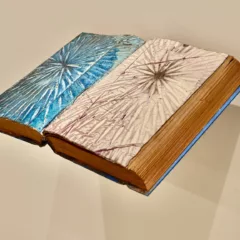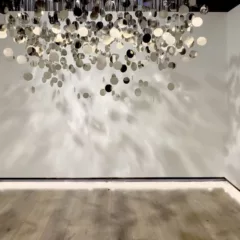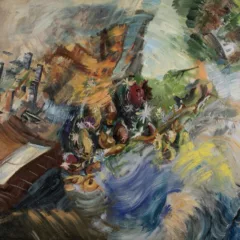Images and Notes from the Floating World brings together works by two painters, Claes Gabriel and Tyler Wilkinson, whose mutually bright-colored palettes might confuse you into thinking the sculptural paintings (by Gabriel) and oil on canvas paintings (by Wilkinson) are similar. But looking past the colors and the fact that both artists use paint on canvas or linen, the works by the two are more different than they are similar. The show is smartly installed (by the artists themselves) combining their work in a way that creates a sense of balance.
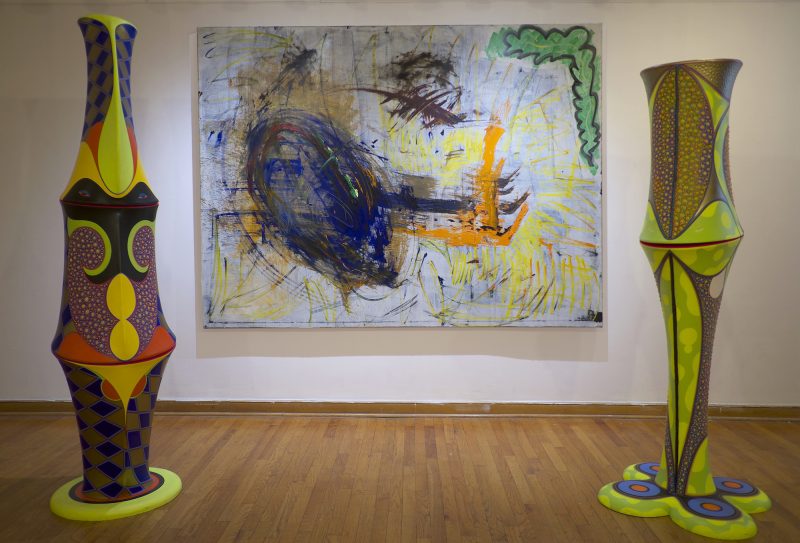
A conversation with the artists brings up philosophical differences
After sitting down for lively conversation with them in the University City Arts League Gallery where the show is up (through the end of the day, Friday, March 24,) I learned that the two artists approach their practices from somewhat contrasting art philosophies.
Claes (pronounced “Clays”) describes himself primarily as a painter, not a sculptor. He began working on 3D structures out of necessity. He was born in Haiti but educated in the U.S., and as an undergrad painter at MICA, he was unable to afford wooden stretcher bars on which to wrap his canvas. But he noticed lots of discarded wood furniture in dumpsters and began cutting it up to use as the supports for his work. His earlier work came from found objects, often discarded furniture, whose wood he would use to determine the shape of the finished piece. To Claes, art is a thing of beauty, and he takes pleasure in turning someone’s trash into a refined object. Although he no longer dumpster dives for his wood but goes like most artists to Home Depot, he is still passionate about re-use and re-cycling. During our conversation, Claes declared, “we are not truly materialistic because we do not value our materials enough”; reflections on consumer culture and questions about our reliance on mass-produced, disposable objects are an important aspect of his practice. (Ed. Note: Libby and Roberta did a studio visit with Gabriel in 2011. Listen to the podcast here.)
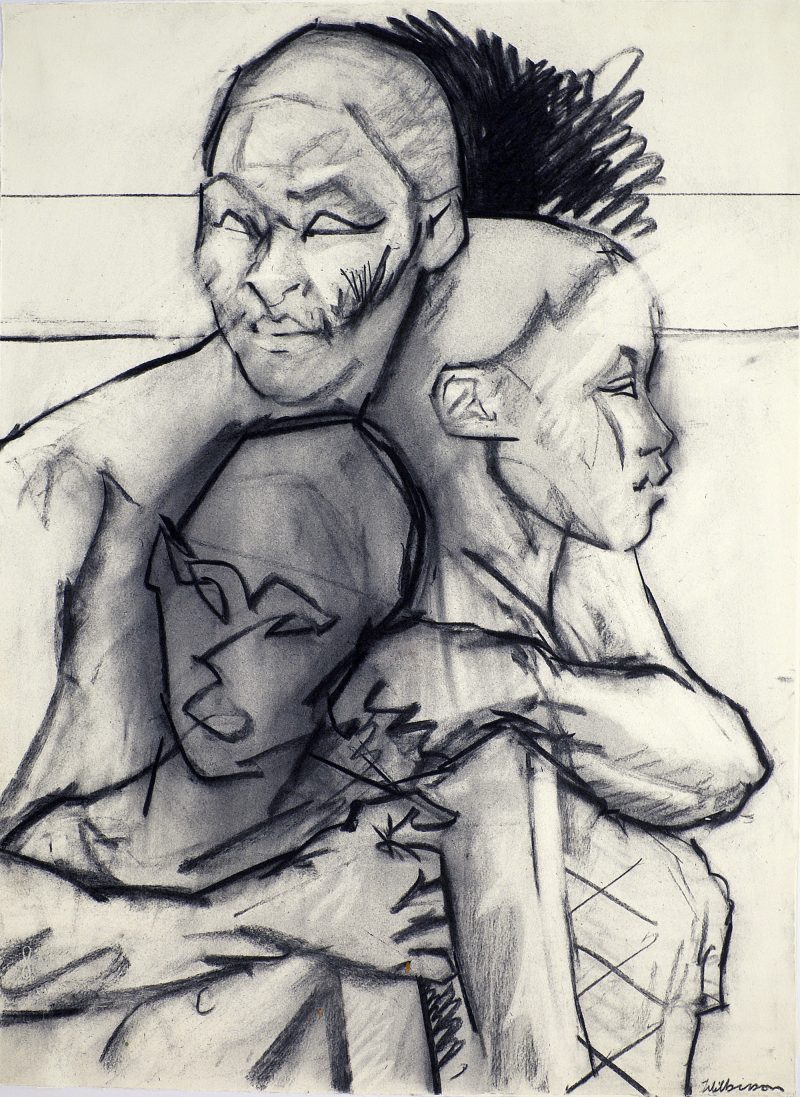
Tyler, on the other hand, refers to himself as an artist who primarily draws, saying that all other art forms stem from drawing as an origin. In his works, you often see pencil or charcoal additions over the oil paint, an assertion of drawing’s importance to the artist.
Painting as Physical
Tyler and Claes (who are studio mates and whose studio time often involves philosophical discussions about art and life) both describe their relationships with painting as a physical experience.
For Claes, painting is a fight. He refers to his sculptural paintings, which evoke totems and often have eyes and mouths, as “she” and “he,” and converses with them in the studio. It’s a struggle against the material’s original form, especially when using found objects, and a surrender to the process. He knows a piece is done when he can bow to it.
Tyler, however, who makes figurative works as well as gestural abstractions, calls painting a dance. His aim is harmony, going by a sort of Plato-ish philosophy: he has an idea for the piece in his head, and tries to adjust his physical performance to inch as close as he can to the ideal concept. For his abstract work, he believes there can be only so many marks on a harmonious piece. Even the most chaotic looking drawings and paintings in the show were approached in a very considered manner.
Harlequin and Snake Charmer as Guardians of Tick on a Tiger’s Back
The Harlequin and the Snake Charmer, by Gabriel, are the two largest sculptural paintings in the exhibition, strategically placed on either side of Tyler’s six by eight foot Tick on a Tiger’s Back. The artists positioned the two totemic works as if to guard the chaotic, vigorous abstraction by Wilkinson in between.
Wilkinson approached this huge abstract piece intending to answer the question, “what does spontaneity look like,” and finished the painting in a day. The textured, gestural work was inspired by Cy Twombly and is meant to represent an ambiguous conflict.
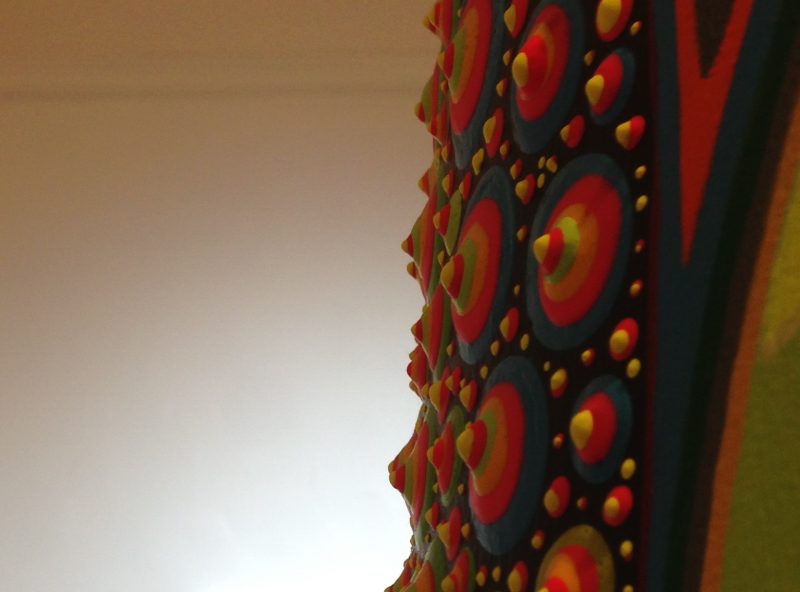
Claes’s Harlequin and Snake Charmer flanking the painting are the total aesthetic opposite. All of his sculptural paintings in the show are meticulously painted totem-like structures with clean lines, intense eyes, and texture that varies from flat matte to shiny metallic to gridded fields of what look like colored nipples. Claes’ pieces have character, craftsmanship and fine design elements; the works included in the show are representative of deities and most have one, if not more, faces intensely staring back at you.
The Haitian Revolution
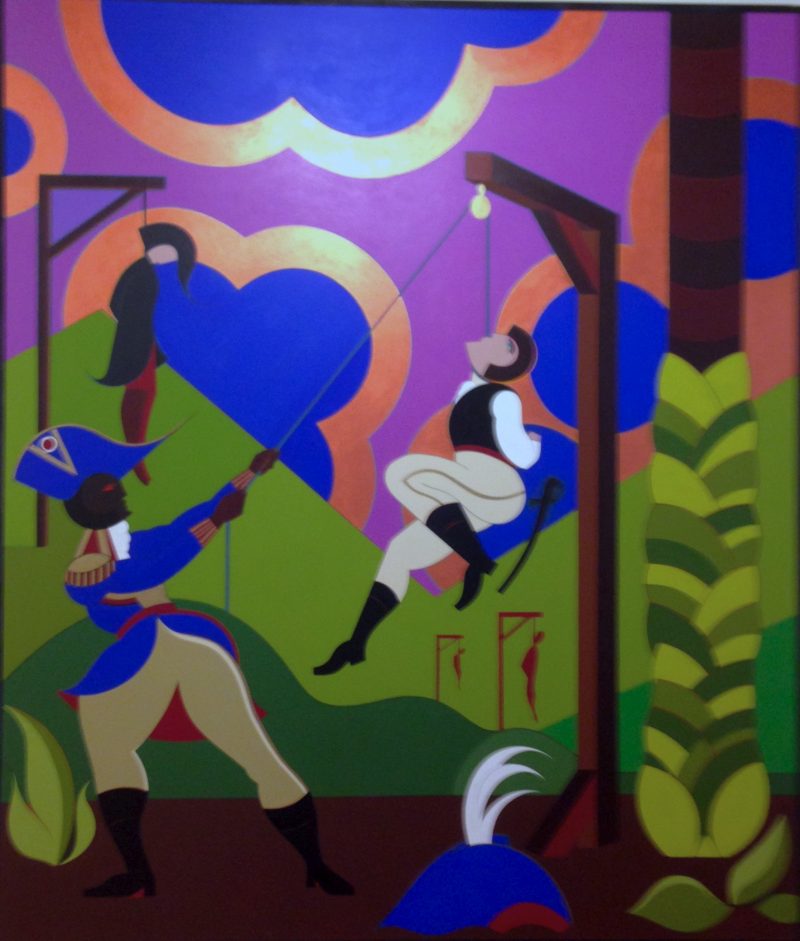
For Claes, The Haitian Revolution was a painting made out of anger, spurred by Donald Trump’s election. Although he generally prefers not to make overtly political art, out of uneasiness with making work that upsets people, the motivation for him now outweighs that discomfort. It is certainly a political image, co-opted from19th century etching by Marcus Rainsford, depicting Haiti’s successful rebellion against the colonial French regime. The painting uses a fairly different color scheme from his sculptural paintings, and shows French officials being hung by Haitian rebels. In the background are silhouettes strongly resembling the work of Kara Walker. While it is obviously a violent image, the intention was solidarity. The story of the revolution (led by former slaves, resulting in the overthrow of colonial rule and establishment of an independent nation) is a symbol of black empowerment to induce social change. This concept and background is especially important to Claes, who is a Haitian native.
The Green Room
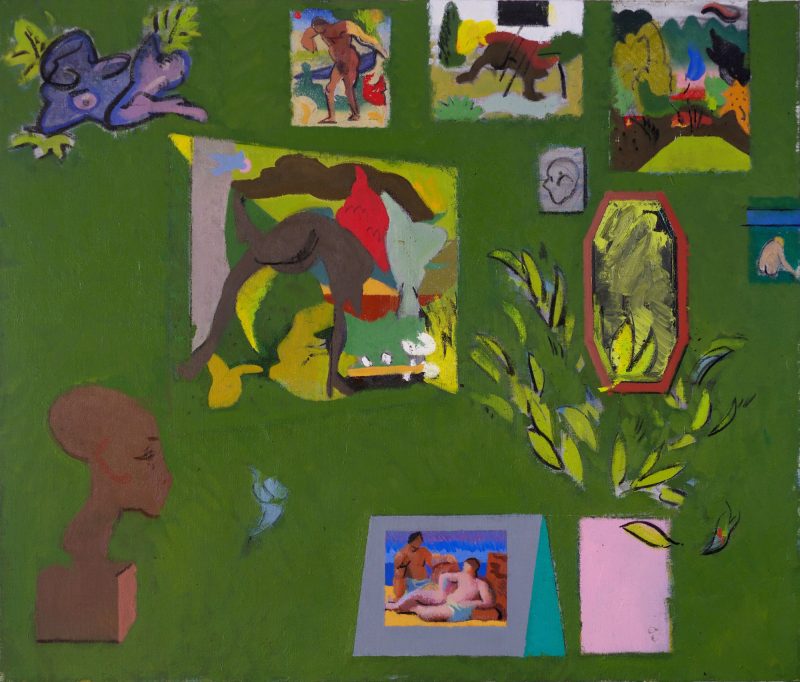
Tyler’s work is political, though not necessarily in image. The artist carefully chooses images and materials to infuse his work with historical reference. He clearly has a deep admiration for traditional Western art, and standards such as Matisse and Picasso are referenced (and personalized) in this show. In the Green Room, Tyler is emulating and subverting Matisse at once. The piece is a reference to Matisse’s Red Room, but the composition is a still life of Wilkinson’s paintings hanging in his studio. The painting uses an interesting mix of flat color and abrupt changes in style that look like they could be collaged. Tyler prefers that his work not be overtly political, but hints are there.
Harmony in two Different Styles
Even though Claes’ and Tyler’s work is vastly different from one another, this show brought their unique styles into conversation with one another: slow-and-deliberate pairs with hot-and-physical, to harmonize and converse about art, culture and life.
Images and Notes from the Floating World will be up at the University City Arts League until the end of the day Friday, March 24th. More about Tyler Wilkinson here and about Claes Gabriel here.


